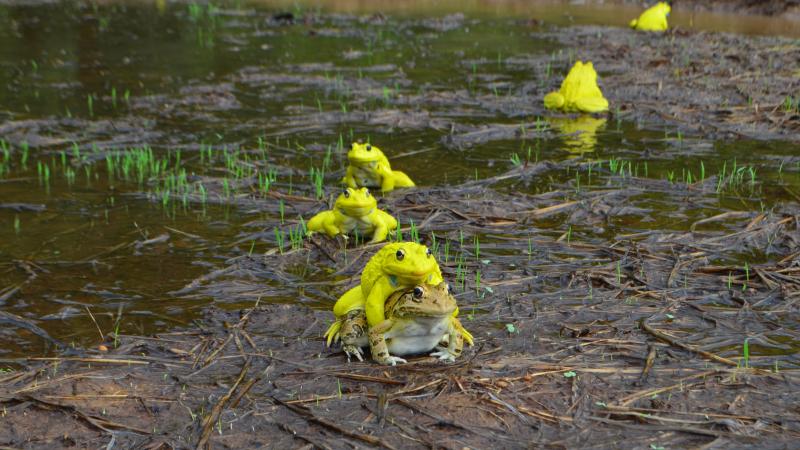
The Indian bullfrog is a standout specimen of the amphibian line-up in the picturesque Andaman Islands. He has a loud, guttural croak, and he’s distinctively bigger than his native cousins. These marked differences have been used to jog people’s memories now, to find out how the bullfrog became an invasive species in these tropical islands.
In a recent study, Mr. Nitya Prakash Mohanty and Dr. John Measey from the Stellenbosch University, South Africa, tried to map the invasion history of these frogs from the early 2000s, which was when it was first reported in the islands. Through their study, published in Biological Invasions, they show the value of conducting public surveys to understand the spread of invasive species, and throw light on a biological invasion we know little about. The study was supported by grants from the Inlaks Shivdasani Foundation Ravi Sankaran Fellowship Programme, the Rufford Small Grant, the Center for Invasion Biology and the Department of Botany and Zoology, Stellenbosch University.
A species is considered invasive when it reproduces and spreads successfully in a non-native area, where it may have harmful effects on native plants and animals. The Indian bullfrog (Hoplobatrachus tigerinus) was likely introduced to the Andamans in the early 2000s. By 2009, these frogs were found on several islands and were considered invasive. In the present study, the ecologists find that the frog was introduced to the islands from mainland India (most probably from West Bengal). From there, it journeyed to several islands in the archipelago, aided by people. While most amphibians cannot cross salt water naturally, this frog was dispersed by humans. Local people also say that bullfrog tadpoles were accidentally mixed with fish fingerlings, which are traded and reared in many of the roughly 3800 ponds of the archipelago. This may have been a major cause for their massive spread.
A majority of the local people who the researchers surveyed reported that the frog caused economic loss, as it is preys on reared fish and poultry. Despite this, humans intentionally spread this invasive species within and between islands.
“Most intentional introductions within the islands were for consumption and novelty. Only later did people see it proliferating to 'pest' proportions, which in turn led to an aversion to eating it”, comments Mr. Mohanty.
The study also focused on the proliferation of the frogs, by using a combination of field sampling and surveys to identify dispersal hubs – sites which may have contributed disproportionately to the invasion. In the evenings, the researchers looked for frogs in and around villages to corroborate local people’s claims about the frogs’ presence or absence. They surveyed farmers, aquaculturists and plantation workers, who worked mostly outdoors and were more likely to spot the conspicuous frog. “These people were super involved in our surveys from the get-go as it is a species with strong perceptions attached to it. The issue is also ‘closer to home’ literally, given the species is in their backyard”.
The Indian bullfrog is a human commensal, living in close association with humans. Even though it is the first known amphibian to invade the Andamans, this is not the first island the frog has made itself comfortable in. It is invasive in Madagascar, and possibly in the Maldives. Yet, we know very little about how these invasions have occurred, and how the frog has proliferated to such proportions. Identifying possible dispersal hubs, pathways, and understanding their role in the exponential spread of the species could prove crucial to managing the frogs and detecting future invasions more effectively.
The survey-based approach used in the current study can throw light on the initial stages of invasions when numbers are often too low to catch the attention of the scientific community. As long as people can quickly identify the species in question, and recall when and where they first began seeing it, public surveys are a great way to trace the invasion history of species.
“If the species has a strong positive and/or negative perception, then it would be better identified and its invasion better recalled. For example, the invasion of the giant African snail (Achatina fulica) in several parts of India is perceived to cause economic loss and therefore, have low misidentification probabilities. Similarly, the many introduced catfishes (e.g. Clarias gariepinus) and tilapias will have associated stakeholders who can recall the invasion reliably”, explains Mr. Mohanty.
In the meanwhile, the bullfrog is likely still being ferried around the islands, unintentionally or intentionally. Survey studies like this one can also help assess different perceptions of the local community on such invasive species, which must feed into future studies attempting to quantify the economic loss brought about by them. The current study is also an attempt at capturing such perceptions about the invasive Indian bullfrogs.





